Genetic Material Report
VerifiedAdded on 2019/10/01
|9
|2630
|366
Report
AI Summary
This report comprehensively details genetic material, focusing on DNA and RNA's roles in inheritance, protein synthesis, and cellular functions. It traces the historical evolution of our understanding of genetic material, from the discovery of chromosomes to the advancements in genome sequencing and its applications. The report explains the structure and function of DNA, including genotype and phenotype, and explores the uses of genome data in various fields, such as medicine and ecological genomics. It also discusses the challenges associated with using DNA as genetic material, including the complexities of three-dimensional genome structure, gene therapy limitations, and legal implications of DNA testing. Finally, it describes the organization of cells through intracellular and intercellular communication.

GENETIC MAATERIAL
Paraphrase This Document
Need a fresh take? Get an instant paraphrase of this document with our AI Paraphraser
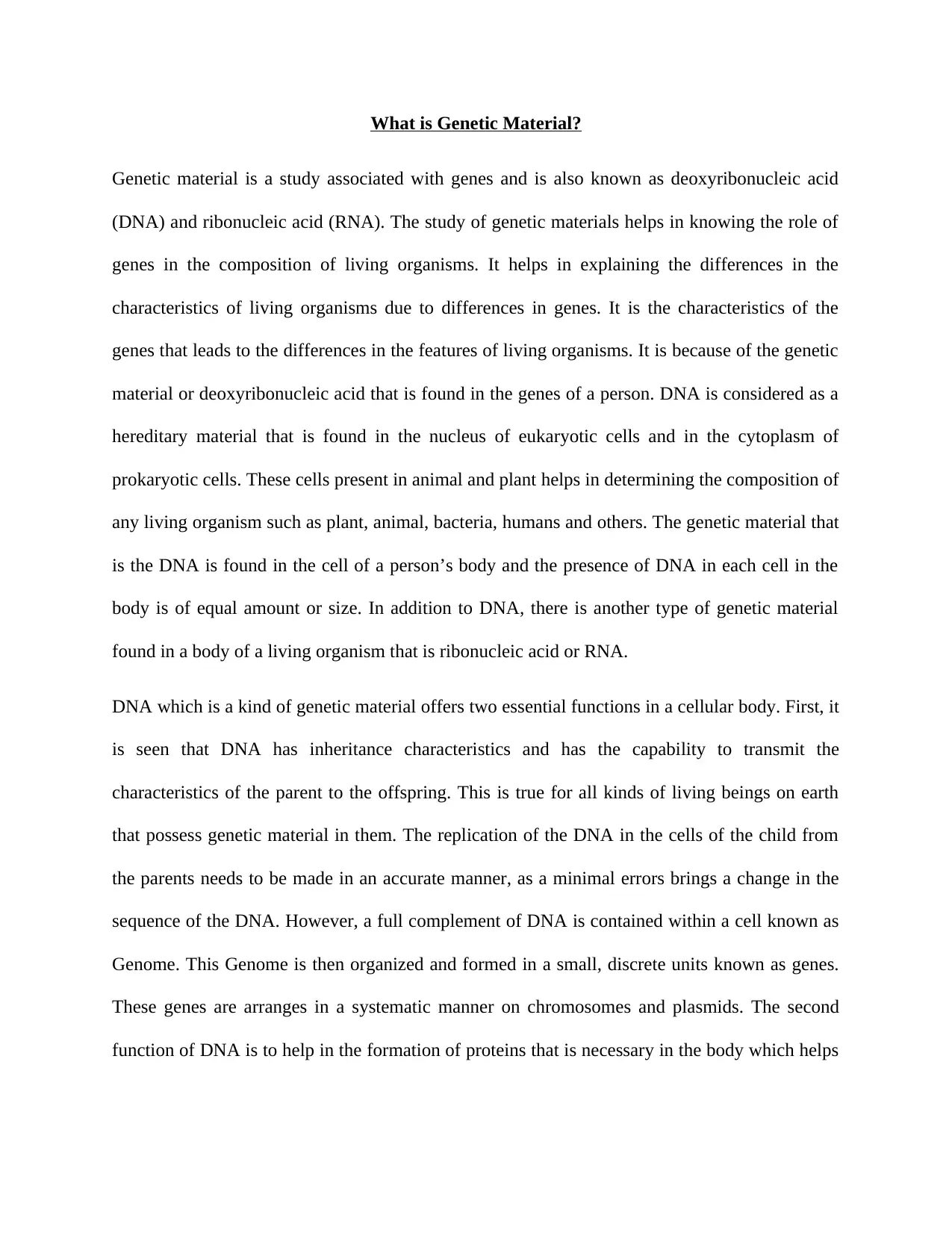
What is Genetic Material?
Genetic material is a study associated with genes and is also known as deoxyribonucleic acid
(DNA) and ribonucleic acid (RNA). The study of genetic materials helps in knowing the role of
genes in the composition of living organisms. It helps in explaining the differences in the
characteristics of living organisms due to differences in genes. It is the characteristics of the
genes that leads to the differences in the features of living organisms. It is because of the genetic
material or deoxyribonucleic acid that is found in the genes of a person. DNA is considered as a
hereditary material that is found in the nucleus of eukaryotic cells and in the cytoplasm of
prokaryotic cells. These cells present in animal and plant helps in determining the composition of
any living organism such as plant, animal, bacteria, humans and others. The genetic material that
is the DNA is found in the cell of a person’s body and the presence of DNA in each cell in the
body is of equal amount or size. In addition to DNA, there is another type of genetic material
found in a body of a living organism that is ribonucleic acid or RNA.
DNA which is a kind of genetic material offers two essential functions in a cellular body. First, it
is seen that DNA has inheritance characteristics and has the capability to transmit the
characteristics of the parent to the offspring. This is true for all kinds of living beings on earth
that possess genetic material in them. The replication of the DNA in the cells of the child from
the parents needs to be made in an accurate manner, as a minimal errors brings a change in the
sequence of the DNA. However, a full complement of DNA is contained within a cell known as
Genome. This Genome is then organized and formed in a small, discrete units known as genes.
These genes are arranges in a systematic manner on chromosomes and plasmids. The second
function of DNA is to help in the formation of proteins that is necessary in the body which helps
Genetic material is a study associated with genes and is also known as deoxyribonucleic acid
(DNA) and ribonucleic acid (RNA). The study of genetic materials helps in knowing the role of
genes in the composition of living organisms. It helps in explaining the differences in the
characteristics of living organisms due to differences in genes. It is the characteristics of the
genes that leads to the differences in the features of living organisms. It is because of the genetic
material or deoxyribonucleic acid that is found in the genes of a person. DNA is considered as a
hereditary material that is found in the nucleus of eukaryotic cells and in the cytoplasm of
prokaryotic cells. These cells present in animal and plant helps in determining the composition of
any living organism such as plant, animal, bacteria, humans and others. The genetic material that
is the DNA is found in the cell of a person’s body and the presence of DNA in each cell in the
body is of equal amount or size. In addition to DNA, there is another type of genetic material
found in a body of a living organism that is ribonucleic acid or RNA.
DNA which is a kind of genetic material offers two essential functions in a cellular body. First, it
is seen that DNA has inheritance characteristics and has the capability to transmit the
characteristics of the parent to the offspring. This is true for all kinds of living beings on earth
that possess genetic material in them. The replication of the DNA in the cells of the child from
the parents needs to be made in an accurate manner, as a minimal errors brings a change in the
sequence of the DNA. However, a full complement of DNA is contained within a cell known as
Genome. This Genome is then organized and formed in a small, discrete units known as genes.
These genes are arranges in a systematic manner on chromosomes and plasmids. The second
function of DNA is to help in the formation of proteins that is necessary in the body which helps
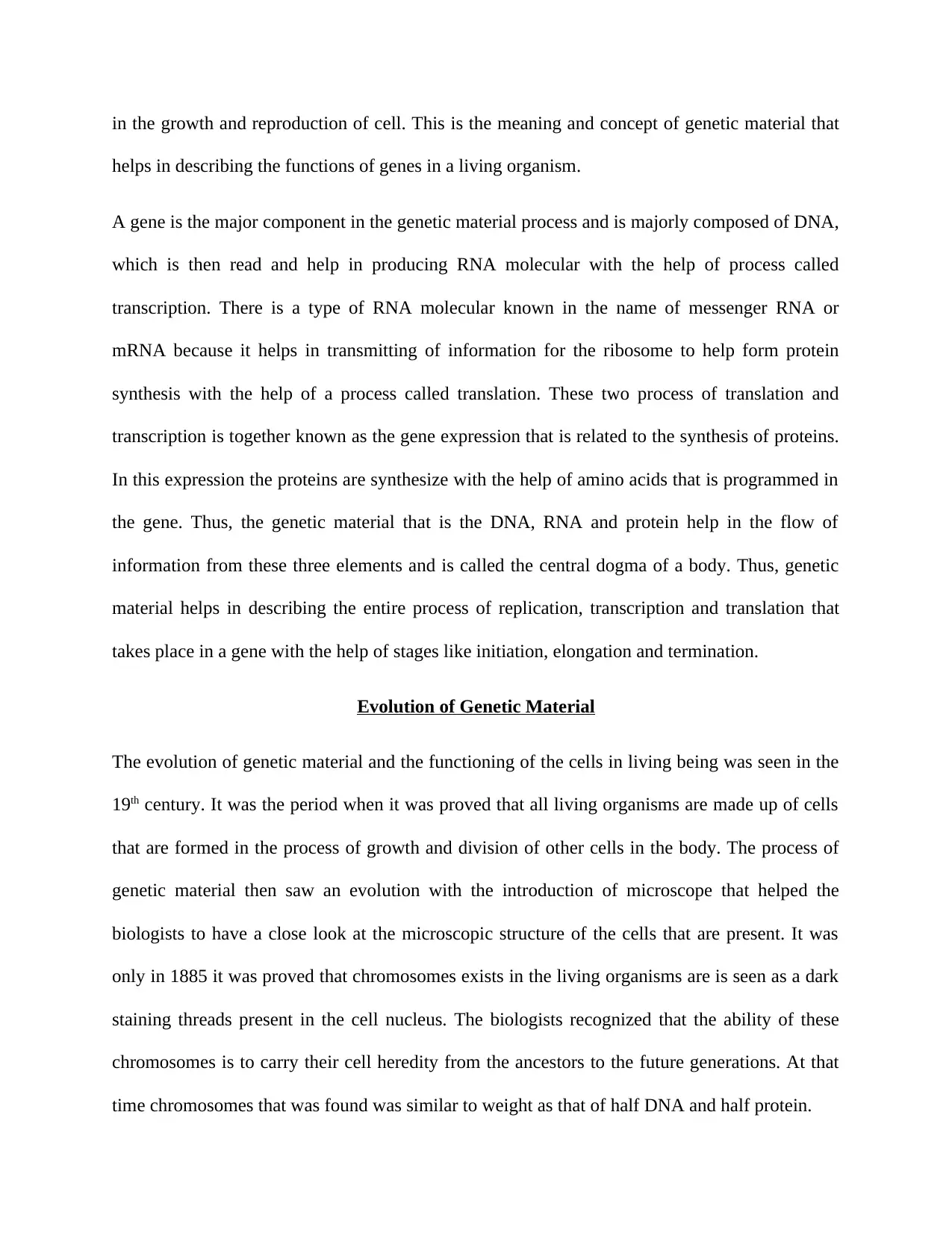
in the growth and reproduction of cell. This is the meaning and concept of genetic material that
helps in describing the functions of genes in a living organism.
A gene is the major component in the genetic material process and is majorly composed of DNA,
which is then read and help in producing RNA molecular with the help of process called
transcription. There is a type of RNA molecular known in the name of messenger RNA or
mRNA because it helps in transmitting of information for the ribosome to help form protein
synthesis with the help of a process called translation. These two process of translation and
transcription is together known as the gene expression that is related to the synthesis of proteins.
In this expression the proteins are synthesize with the help of amino acids that is programmed in
the gene. Thus, the genetic material that is the DNA, RNA and protein help in the flow of
information from these three elements and is called the central dogma of a body. Thus, genetic
material helps in describing the entire process of replication, transcription and translation that
takes place in a gene with the help of stages like initiation, elongation and termination.
Evolution of Genetic Material
The evolution of genetic material and the functioning of the cells in living being was seen in the
19th century. It was the period when it was proved that all living organisms are made up of cells
that are formed in the process of growth and division of other cells in the body. The process of
genetic material then saw an evolution with the introduction of microscope that helped the
biologists to have a close look at the microscopic structure of the cells that are present. It was
only in 1885 it was proved that chromosomes exists in the living organisms are is seen as a dark
staining threads present in the cell nucleus. The biologists recognized that the ability of these
chromosomes is to carry their cell heredity from the ancestors to the future generations. At that
time chromosomes that was found was similar to weight as that of half DNA and half protein.
helps in describing the functions of genes in a living organism.
A gene is the major component in the genetic material process and is majorly composed of DNA,
which is then read and help in producing RNA molecular with the help of process called
transcription. There is a type of RNA molecular known in the name of messenger RNA or
mRNA because it helps in transmitting of information for the ribosome to help form protein
synthesis with the help of a process called translation. These two process of translation and
transcription is together known as the gene expression that is related to the synthesis of proteins.
In this expression the proteins are synthesize with the help of amino acids that is programmed in
the gene. Thus, the genetic material that is the DNA, RNA and protein help in the flow of
information from these three elements and is called the central dogma of a body. Thus, genetic
material helps in describing the entire process of replication, transcription and translation that
takes place in a gene with the help of stages like initiation, elongation and termination.
Evolution of Genetic Material
The evolution of genetic material and the functioning of the cells in living being was seen in the
19th century. It was the period when it was proved that all living organisms are made up of cells
that are formed in the process of growth and division of other cells in the body. The process of
genetic material then saw an evolution with the introduction of microscope that helped the
biologists to have a close look at the microscopic structure of the cells that are present. It was
only in 1885 it was proved that chromosomes exists in the living organisms are is seen as a dark
staining threads present in the cell nucleus. The biologists recognized that the ability of these
chromosomes is to carry their cell heredity from the ancestors to the future generations. At that
time chromosomes that was found was similar to weight as that of half DNA and half protein.
⊘ This is a preview!⊘
Do you want full access?
Subscribe today to unlock all pages.

Trusted by 1+ million students worldwide
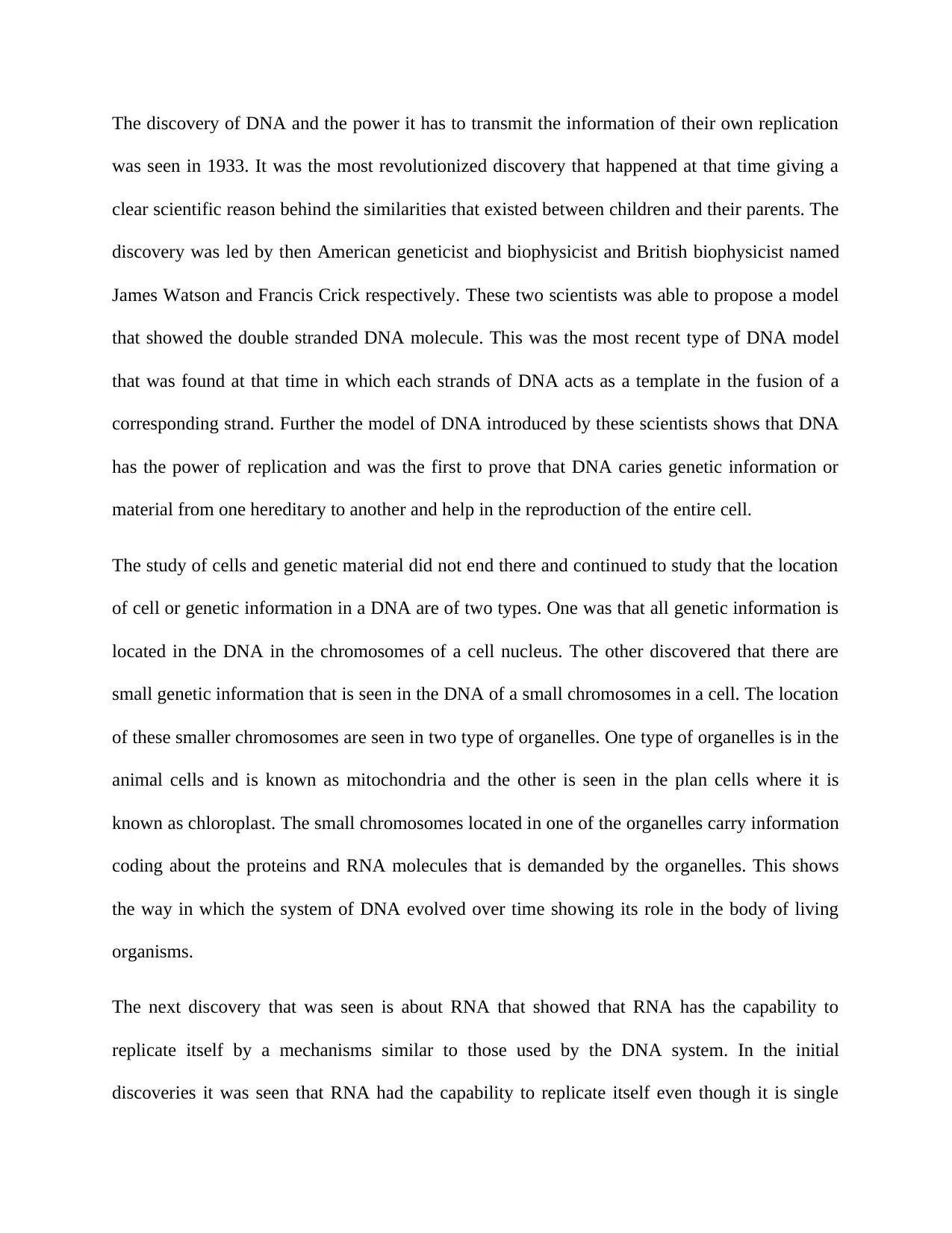
The discovery of DNA and the power it has to transmit the information of their own replication
was seen in 1933. It was the most revolutionized discovery that happened at that time giving a
clear scientific reason behind the similarities that existed between children and their parents. The
discovery was led by then American geneticist and biophysicist and British biophysicist named
James Watson and Francis Crick respectively. These two scientists was able to propose a model
that showed the double stranded DNA molecule. This was the most recent type of DNA model
that was found at that time in which each strands of DNA acts as a template in the fusion of a
corresponding strand. Further the model of DNA introduced by these scientists shows that DNA
has the power of replication and was the first to prove that DNA caries genetic information or
material from one hereditary to another and help in the reproduction of the entire cell.
The study of cells and genetic material did not end there and continued to study that the location
of cell or genetic information in a DNA are of two types. One was that all genetic information is
located in the DNA in the chromosomes of a cell nucleus. The other discovered that there are
small genetic information that is seen in the DNA of a small chromosomes in a cell. The location
of these smaller chromosomes are seen in two type of organelles. One type of organelles is in the
animal cells and is known as mitochondria and the other is seen in the plan cells where it is
known as chloroplast. The small chromosomes located in one of the organelles carry information
coding about the proteins and RNA molecules that is demanded by the organelles. This shows
the way in which the system of DNA evolved over time showing its role in the body of living
organisms.
The next discovery that was seen is about RNA that showed that RNA has the capability to
replicate itself by a mechanisms similar to those used by the DNA system. In the initial
discoveries it was seen that RNA had the capability to replicate itself even though it is single
was seen in 1933. It was the most revolutionized discovery that happened at that time giving a
clear scientific reason behind the similarities that existed between children and their parents. The
discovery was led by then American geneticist and biophysicist and British biophysicist named
James Watson and Francis Crick respectively. These two scientists was able to propose a model
that showed the double stranded DNA molecule. This was the most recent type of DNA model
that was found at that time in which each strands of DNA acts as a template in the fusion of a
corresponding strand. Further the model of DNA introduced by these scientists shows that DNA
has the power of replication and was the first to prove that DNA caries genetic information or
material from one hereditary to another and help in the reproduction of the entire cell.
The study of cells and genetic material did not end there and continued to study that the location
of cell or genetic information in a DNA are of two types. One was that all genetic information is
located in the DNA in the chromosomes of a cell nucleus. The other discovered that there are
small genetic information that is seen in the DNA of a small chromosomes in a cell. The location
of these smaller chromosomes are seen in two type of organelles. One type of organelles is in the
animal cells and is known as mitochondria and the other is seen in the plan cells where it is
known as chloroplast. The small chromosomes located in one of the organelles carry information
coding about the proteins and RNA molecules that is demanded by the organelles. This shows
the way in which the system of DNA evolved over time showing its role in the body of living
organisms.
The next discovery that was seen is about RNA that showed that RNA has the capability to
replicate itself by a mechanisms similar to those used by the DNA system. In the initial
discoveries it was seen that RNA had the capability to replicate itself even though it is single
Paraphrase This Document
Need a fresh take? Get an instant paraphrase of this document with our AI Paraphraser
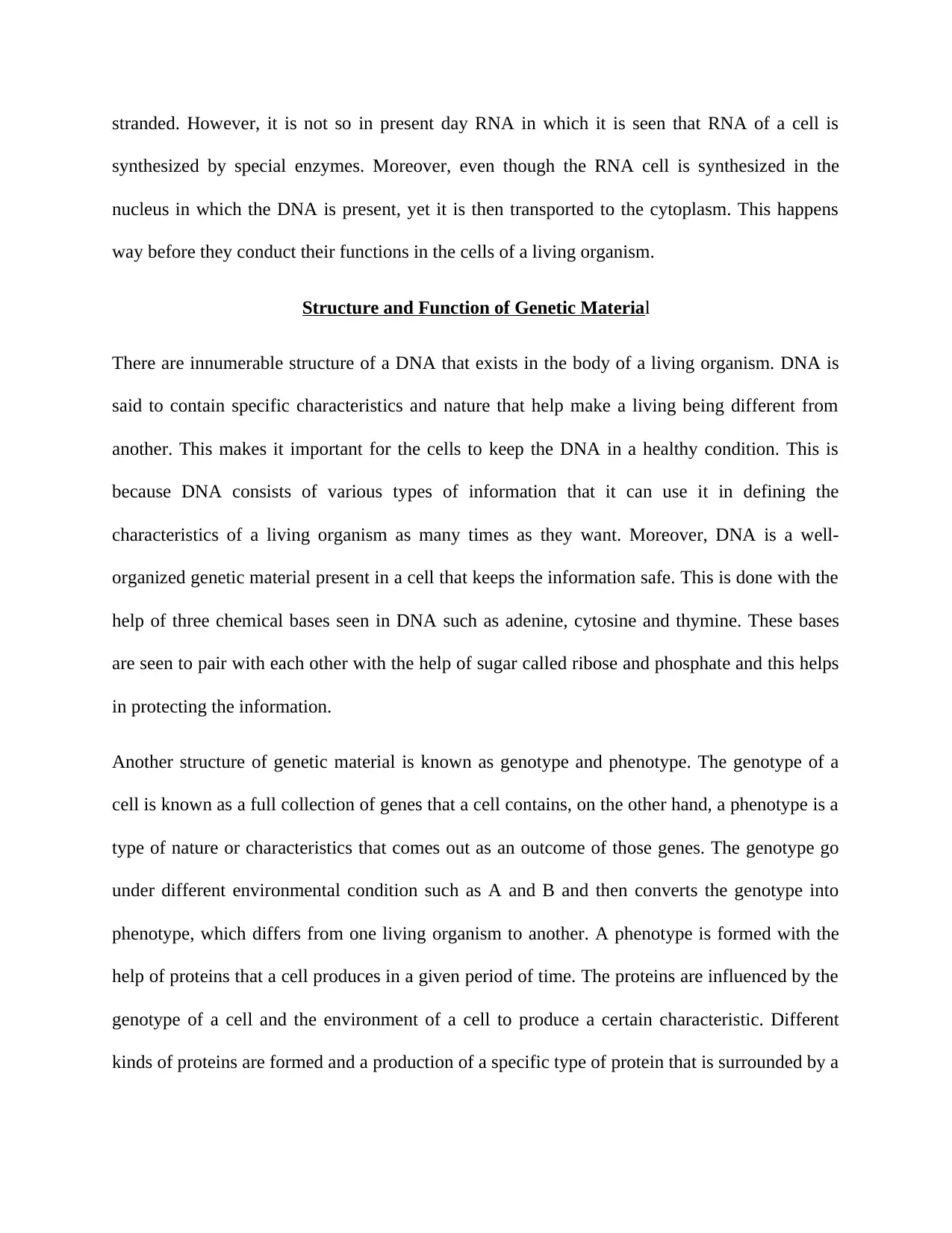
stranded. However, it is not so in present day RNA in which it is seen that RNA of a cell is
synthesized by special enzymes. Moreover, even though the RNA cell is synthesized in the
nucleus in which the DNA is present, yet it is then transported to the cytoplasm. This happens
way before they conduct their functions in the cells of a living organism.
Structure and Function of Genetic Material
There are innumerable structure of a DNA that exists in the body of a living organism. DNA is
said to contain specific characteristics and nature that help make a living being different from
another. This makes it important for the cells to keep the DNA in a healthy condition. This is
because DNA consists of various types of information that it can use it in defining the
characteristics of a living organism as many times as they want. Moreover, DNA is a well-
organized genetic material present in a cell that keeps the information safe. This is done with the
help of three chemical bases seen in DNA such as adenine, cytosine and thymine. These bases
are seen to pair with each other with the help of sugar called ribose and phosphate and this helps
in protecting the information.
Another structure of genetic material is known as genotype and phenotype. The genotype of a
cell is known as a full collection of genes that a cell contains, on the other hand, a phenotype is a
type of nature or characteristics that comes out as an outcome of those genes. The genotype go
under different environmental condition such as A and B and then converts the genotype into
phenotype, which differs from one living organism to another. A phenotype is formed with the
help of proteins that a cell produces in a given period of time. The proteins are influenced by the
genotype of a cell and the environment of a cell to produce a certain characteristic. Different
kinds of proteins are formed and a production of a specific type of protein that is surrounded by a
synthesized by special enzymes. Moreover, even though the RNA cell is synthesized in the
nucleus in which the DNA is present, yet it is then transported to the cytoplasm. This happens
way before they conduct their functions in the cells of a living organism.
Structure and Function of Genetic Material
There are innumerable structure of a DNA that exists in the body of a living organism. DNA is
said to contain specific characteristics and nature that help make a living being different from
another. This makes it important for the cells to keep the DNA in a healthy condition. This is
because DNA consists of various types of information that it can use it in defining the
characteristics of a living organism as many times as they want. Moreover, DNA is a well-
organized genetic material present in a cell that keeps the information safe. This is done with the
help of three chemical bases seen in DNA such as adenine, cytosine and thymine. These bases
are seen to pair with each other with the help of sugar called ribose and phosphate and this helps
in protecting the information.
Another structure of genetic material is known as genotype and phenotype. The genotype of a
cell is known as a full collection of genes that a cell contains, on the other hand, a phenotype is a
type of nature or characteristics that comes out as an outcome of those genes. The genotype go
under different environmental condition such as A and B and then converts the genotype into
phenotype, which differs from one living organism to another. A phenotype is formed with the
help of proteins that a cell produces in a given period of time. The proteins are influenced by the
genotype of a cell and the environment of a cell to produce a certain characteristic. Different
kinds of proteins are formed and a production of a specific type of protein that is surrounded by a
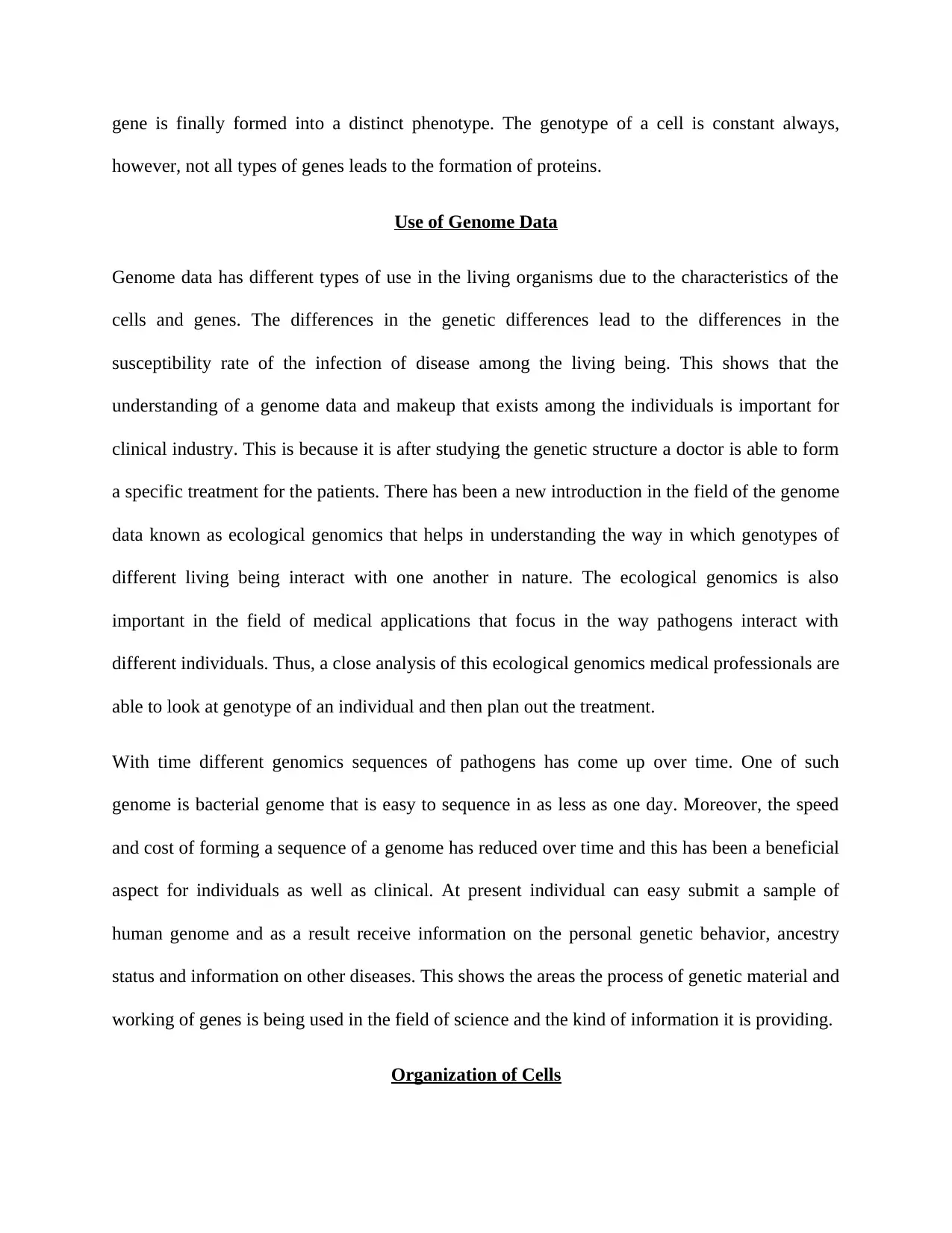
gene is finally formed into a distinct phenotype. The genotype of a cell is constant always,
however, not all types of genes leads to the formation of proteins.
Use of Genome Data
Genome data has different types of use in the living organisms due to the characteristics of the
cells and genes. The differences in the genetic differences lead to the differences in the
susceptibility rate of the infection of disease among the living being. This shows that the
understanding of a genome data and makeup that exists among the individuals is important for
clinical industry. This is because it is after studying the genetic structure a doctor is able to form
a specific treatment for the patients. There has been a new introduction in the field of the genome
data known as ecological genomics that helps in understanding the way in which genotypes of
different living being interact with one another in nature. The ecological genomics is also
important in the field of medical applications that focus in the way pathogens interact with
different individuals. Thus, a close analysis of this ecological genomics medical professionals are
able to look at genotype of an individual and then plan out the treatment.
With time different genomics sequences of pathogens has come up over time. One of such
genome is bacterial genome that is easy to sequence in as less as one day. Moreover, the speed
and cost of forming a sequence of a genome has reduced over time and this has been a beneficial
aspect for individuals as well as clinical. At present individual can easy submit a sample of
human genome and as a result receive information on the personal genetic behavior, ancestry
status and information on other diseases. This shows the areas the process of genetic material and
working of genes is being used in the field of science and the kind of information it is providing.
Organization of Cells
however, not all types of genes leads to the formation of proteins.
Use of Genome Data
Genome data has different types of use in the living organisms due to the characteristics of the
cells and genes. The differences in the genetic differences lead to the differences in the
susceptibility rate of the infection of disease among the living being. This shows that the
understanding of a genome data and makeup that exists among the individuals is important for
clinical industry. This is because it is after studying the genetic structure a doctor is able to form
a specific treatment for the patients. There has been a new introduction in the field of the genome
data known as ecological genomics that helps in understanding the way in which genotypes of
different living being interact with one another in nature. The ecological genomics is also
important in the field of medical applications that focus in the way pathogens interact with
different individuals. Thus, a close analysis of this ecological genomics medical professionals are
able to look at genotype of an individual and then plan out the treatment.
With time different genomics sequences of pathogens has come up over time. One of such
genome is bacterial genome that is easy to sequence in as less as one day. Moreover, the speed
and cost of forming a sequence of a genome has reduced over time and this has been a beneficial
aspect for individuals as well as clinical. At present individual can easy submit a sample of
human genome and as a result receive information on the personal genetic behavior, ancestry
status and information on other diseases. This shows the areas the process of genetic material and
working of genes is being used in the field of science and the kind of information it is providing.
Organization of Cells
⊘ This is a preview!⊘
Do you want full access?
Subscribe today to unlock all pages.

Trusted by 1+ million students worldwide
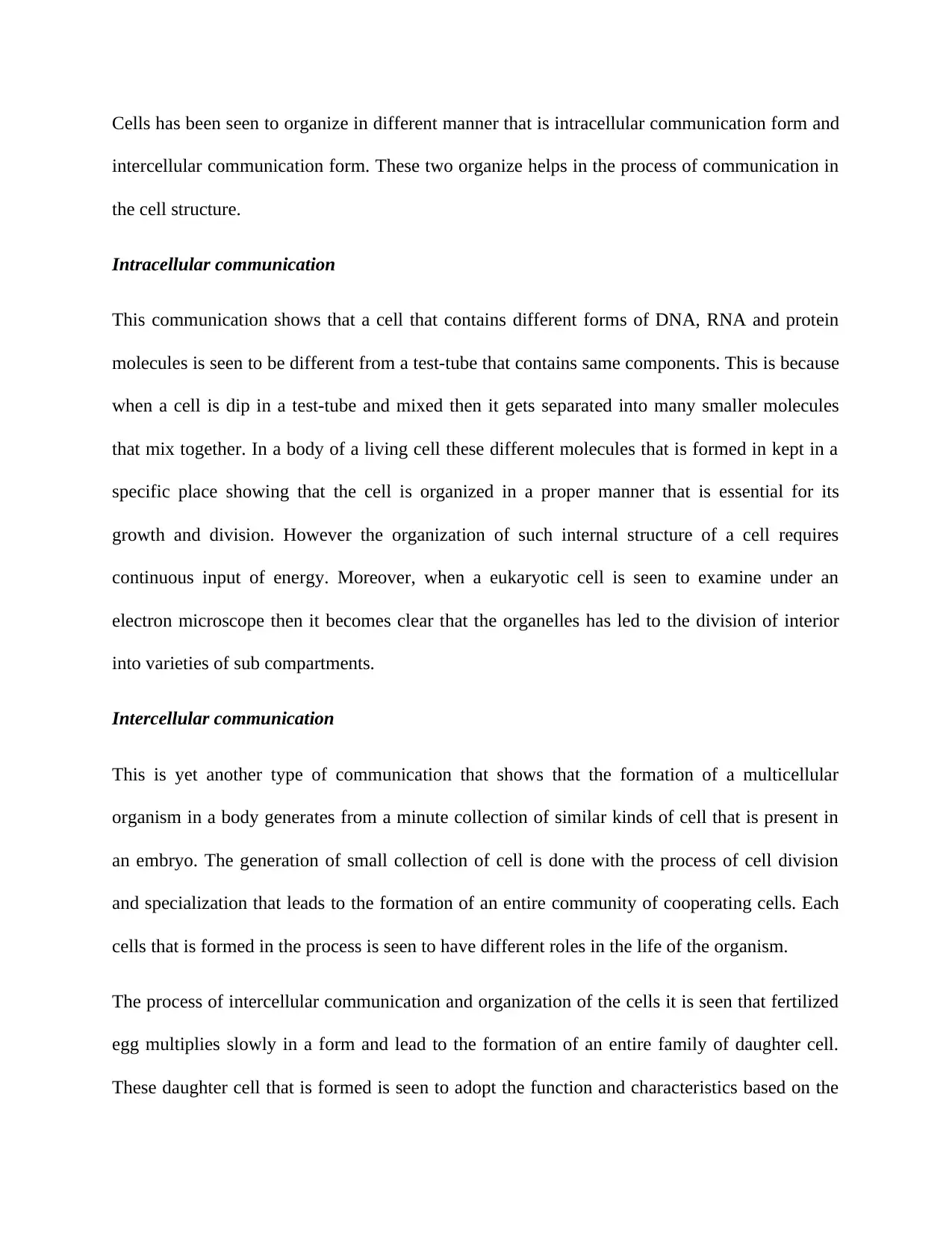
Cells has been seen to organize in different manner that is intracellular communication form and
intercellular communication form. These two organize helps in the process of communication in
the cell structure.
Intracellular communication
This communication shows that a cell that contains different forms of DNA, RNA and protein
molecules is seen to be different from a test-tube that contains same components. This is because
when a cell is dip in a test-tube and mixed then it gets separated into many smaller molecules
that mix together. In a body of a living cell these different molecules that is formed in kept in a
specific place showing that the cell is organized in a proper manner that is essential for its
growth and division. However the organization of such internal structure of a cell requires
continuous input of energy. Moreover, when a eukaryotic cell is seen to examine under an
electron microscope then it becomes clear that the organelles has led to the division of interior
into varieties of sub compartments.
Intercellular communication
This is yet another type of communication that shows that the formation of a multicellular
organism in a body generates from a minute collection of similar kinds of cell that is present in
an embryo. The generation of small collection of cell is done with the process of cell division
and specialization that leads to the formation of an entire community of cooperating cells. Each
cells that is formed in the process is seen to have different roles in the life of the organism.
The process of intercellular communication and organization of the cells it is seen that fertilized
egg multiplies slowly in a form and lead to the formation of an entire family of daughter cell.
These daughter cell that is formed is seen to adopt the function and characteristics based on the
intercellular communication form. These two organize helps in the process of communication in
the cell structure.
Intracellular communication
This communication shows that a cell that contains different forms of DNA, RNA and protein
molecules is seen to be different from a test-tube that contains same components. This is because
when a cell is dip in a test-tube and mixed then it gets separated into many smaller molecules
that mix together. In a body of a living cell these different molecules that is formed in kept in a
specific place showing that the cell is organized in a proper manner that is essential for its
growth and division. However the organization of such internal structure of a cell requires
continuous input of energy. Moreover, when a eukaryotic cell is seen to examine under an
electron microscope then it becomes clear that the organelles has led to the division of interior
into varieties of sub compartments.
Intercellular communication
This is yet another type of communication that shows that the formation of a multicellular
organism in a body generates from a minute collection of similar kinds of cell that is present in
an embryo. The generation of small collection of cell is done with the process of cell division
and specialization that leads to the formation of an entire community of cooperating cells. Each
cells that is formed in the process is seen to have different roles in the life of the organism.
The process of intercellular communication and organization of the cells it is seen that fertilized
egg multiplies slowly in a form and lead to the formation of an entire family of daughter cell.
These daughter cell that is formed is seen to adopt the function and characteristics based on the
Paraphrase This Document
Need a fresh take? Get an instant paraphrase of this document with our AI Paraphraser
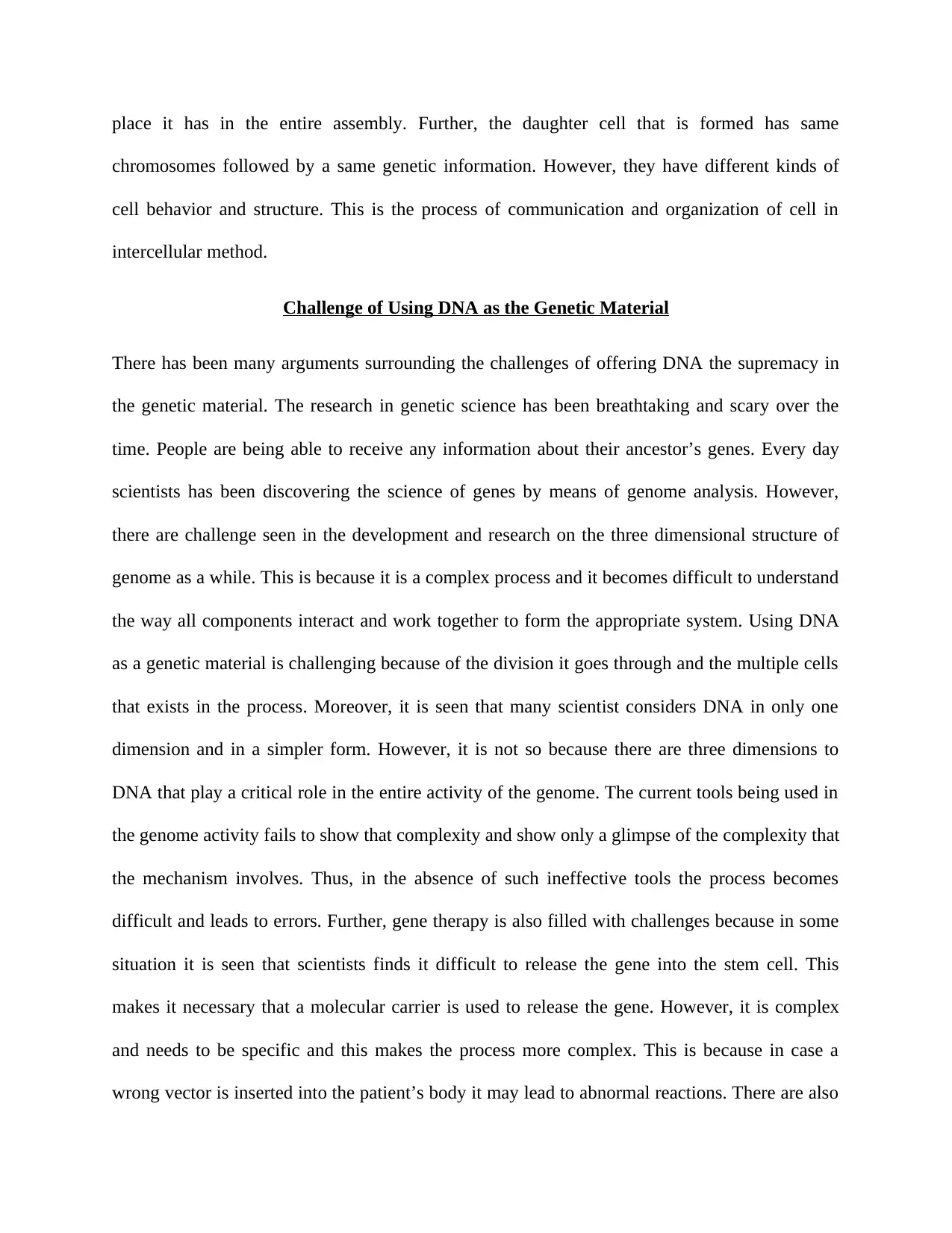
place it has in the entire assembly. Further, the daughter cell that is formed has same
chromosomes followed by a same genetic information. However, they have different kinds of
cell behavior and structure. This is the process of communication and organization of cell in
intercellular method.
Challenge of Using DNA as the Genetic Material
There has been many arguments surrounding the challenges of offering DNA the supremacy in
the genetic material. The research in genetic science has been breathtaking and scary over the
time. People are being able to receive any information about their ancestor’s genes. Every day
scientists has been discovering the science of genes by means of genome analysis. However,
there are challenge seen in the development and research on the three dimensional structure of
genome as a while. This is because it is a complex process and it becomes difficult to understand
the way all components interact and work together to form the appropriate system. Using DNA
as a genetic material is challenging because of the division it goes through and the multiple cells
that exists in the process. Moreover, it is seen that many scientist considers DNA in only one
dimension and in a simpler form. However, it is not so because there are three dimensions to
DNA that play a critical role in the entire activity of the genome. The current tools being used in
the genome activity fails to show that complexity and show only a glimpse of the complexity that
the mechanism involves. Thus, in the absence of such ineffective tools the process becomes
difficult and leads to errors. Further, gene therapy is also filled with challenges because in some
situation it is seen that scientists finds it difficult to release the gene into the stem cell. This
makes it necessary that a molecular carrier is used to release the gene. However, it is complex
and needs to be specific and this makes the process more complex. This is because in case a
wrong vector is inserted into the patient’s body it may lead to abnormal reactions. There are also
chromosomes followed by a same genetic information. However, they have different kinds of
cell behavior and structure. This is the process of communication and organization of cell in
intercellular method.
Challenge of Using DNA as the Genetic Material
There has been many arguments surrounding the challenges of offering DNA the supremacy in
the genetic material. The research in genetic science has been breathtaking and scary over the
time. People are being able to receive any information about their ancestor’s genes. Every day
scientists has been discovering the science of genes by means of genome analysis. However,
there are challenge seen in the development and research on the three dimensional structure of
genome as a while. This is because it is a complex process and it becomes difficult to understand
the way all components interact and work together to form the appropriate system. Using DNA
as a genetic material is challenging because of the division it goes through and the multiple cells
that exists in the process. Moreover, it is seen that many scientist considers DNA in only one
dimension and in a simpler form. However, it is not so because there are three dimensions to
DNA that play a critical role in the entire activity of the genome. The current tools being used in
the genome activity fails to show that complexity and show only a glimpse of the complexity that
the mechanism involves. Thus, in the absence of such ineffective tools the process becomes
difficult and leads to errors. Further, gene therapy is also filled with challenges because in some
situation it is seen that scientists finds it difficult to release the gene into the stem cell. This
makes it necessary that a molecular carrier is used to release the gene. However, it is complex
and needs to be specific and this makes the process more complex. This is because in case a
wrong vector is inserted into the patient’s body it may lead to abnormal reactions. There are also

evidences showing problem with the DNA testing, which has been facing huge legal challenges.
This is because testing of genes of ancestors to test a character of a person is consider to be
illegal. Moreover, DNA has also been used for many other illegal activities after being
considered as a genetic material. This shows the complexities and challenges related to DNA
which is being used as a genetic material.
This is because testing of genes of ancestors to test a character of a person is consider to be
illegal. Moreover, DNA has also been used for many other illegal activities after being
considered as a genetic material. This shows the complexities and challenges related to DNA
which is being used as a genetic material.
⊘ This is a preview!⊘
Do you want full access?
Subscribe today to unlock all pages.

Trusted by 1+ million students worldwide
1 out of 9
Related Documents
Your All-in-One AI-Powered Toolkit for Academic Success.
+13062052269
info@desklib.com
Available 24*7 on WhatsApp / Email
![[object Object]](/_next/static/media/star-bottom.7253800d.svg)
Unlock your academic potential
Copyright © 2020–2025 A2Z Services. All Rights Reserved. Developed and managed by ZUCOL.





